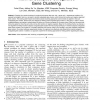400 search results - page 24 / 80 » Subspace evasive sets |
TKDE
2008
13 years 7 months ago
2008
Clustering is a popular technique for analyzing microarray data sets, with n genes and m experimental conditions. As explored by biologists, there is a real need to identify coregu...
CIVR
2008
Springer
13 years 9 months ago
2008
Springer
Since the emergence of extensive multimedia data, feature fusion has been more and more important for image and video retrieval, indexing and annotation. Existing feature fusion t...
KDD
2004
ACM
14 years 8 months ago
2004
ACM
Traditional clustering is a descriptive task that seeks to identify homogeneous groups of objects based on the values of their attributes. While domain knowledge is always the bes...
TSP
2008
13 years 7 months ago
2008
In this correspondence, parameter estimation of a polynomial phase signal (PPS) in additive white Gaussian noise is addressed. Assuming that the order of the PPS is at least 3, the...
JMLR
2002
13 years 7 months ago
2002
A central problem in learning is selection of an appropriate model. This is typically done by estimating the unknown generalization errors of a set of models to be selected from a...

